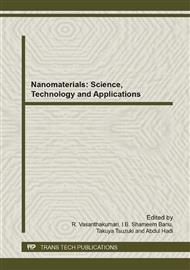[1]
I.O. Sosa, C. Noguez, R.G. Barrera, Optical properties of metal nanoparticles with arbitrary shapes, J. Phys. Chem. B 107(26), (2003) 6269–6275.
DOI: 10.1021/jp0274076
Google Scholar
[2]
B. Liu, H.C. Zeng, Hydrothermal synthesis of ZnO nanorods in the diameter regime of 50 nm, J. Am. Chem. Soc. 125 (2003) 4430–4431.
DOI: 10.1021/ja0299452
Google Scholar
[3]
K. Okuyama, I.W. Lenggoro, Preparation of nanoparticles via spray route, Chem. Eng. Sci. 58 (2003) 537–547.
DOI: 10.1016/s0009-2509(02)00578-x
Google Scholar
[4]
X.L. Hu, Y.J. Zhu, S.W. Wang, Sonochemical and microwave-assisted synthesis of linked single-crystalline ZnO rods, Mater. Chem. Phys. 88 (2004) 421–426.
DOI: 10.1016/j.matchemphys.2004.08.010
Google Scholar
[5]
A. Henglein, M. Giersig, Formation of colloidal silver nanoparticles: Capping action of citrate, J. Phys. Chem. B 103 (1999) 9533-9539.
DOI: 10.1021/jp9925334
Google Scholar
[6]
Y. Bingsheng, M. Houyi, Electrochemical synthesis of silver nanoparticles under protection of poly(n-vinylpyrrolidone), J. Phys. Chem. B 107 (2003) 8898-8904.
Google Scholar
[7]
X. Jiang, Y. Xie, J. Lu, L. Zhu, W. He, Y. Qian, Preparation, characterization, and catalytic effect of CS2-stabilized silver nanoparticles in aqueous solution, Langmuir 17 (2001) 3795-3799.
DOI: 10.1021/la001361v
Google Scholar
[8]
L. Rodriguez-Sanchez, M.C. Blanco, M.A. Lopez-Quintela, Electrochemical synthesis of silver nanoparticles, J. Phys. Chem. B 104 (2000) 9683-9688.
Google Scholar
[9]
P.W. Wu, B. Dunn, V. Doan, B.J. Schwartz, E. Yablonovitch, M. Yamane, Controlling the spontaneous precipitation of silver nanoparticles in sol-gel materials, J. Sol. -Gel Sci. Technol. 19 (2000) 249-252.
DOI: 10.1023/a:1008748608055
Google Scholar
[10]
S. Liang, H. Sheng, Y. Liu, Z. Hio, Y. Lu, H.J. Shen, ZnO Schottky ultraviolet photodetectors, J. Cryst. Growth 225 (2001) 110–113.
DOI: 10.1016/s0022-0248(01)00830-2
Google Scholar
[11]
Y.H. Ni, X.W. Wei, J.M. Hong, Y. Ye, Hydrothermal preparation and optical properties of ZnO nanorods, Mater. Sci. Eng. B 121 (2005) 42–47.
Google Scholar
[12]
S.R. Ghanta, M.H. Rao, K. Muralidharan, Single-pot synthesis of zinc nanoparticles, borane (BH3) and closo-dodecaborate (B12H12)2− using LiBH4 under mild conditions, Dalton Trans., 42 (2013) 8420–8425.
DOI: 10.1039/c3dt00092c
Google Scholar
[13]
G.B. Giovenzana, G. Palmisano, E.D. Grosso, L. Giovannelli, A. Penoni, T. Pilati, Polycyclic compounds from aminopolyols and α-dicarbonyls: structure and application in the synthesis of exoditopic ligands, Org. Biomol. Chem. 3 (2005) 1489–1494.
DOI: 10.1039/b500580a
Google Scholar
[14]
S. C Singh, R. Gopal, Zinc nanoparticles in solution by laser ablation technique, Bull. Mater. Sci., 30 (2007) 291–293.
DOI: 10.1007/s12034-007-0048-z
Google Scholar


